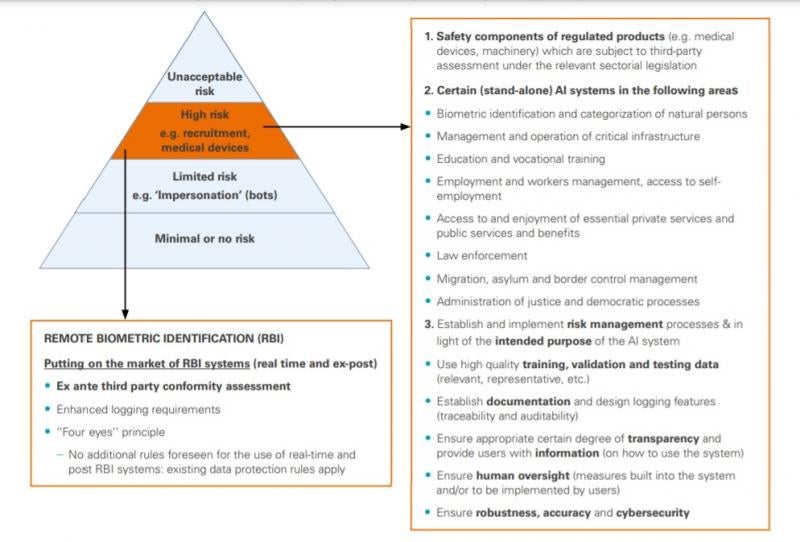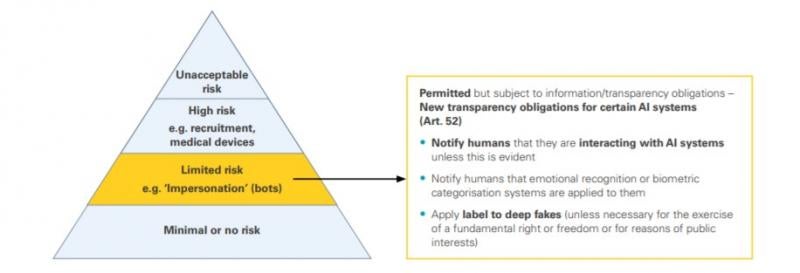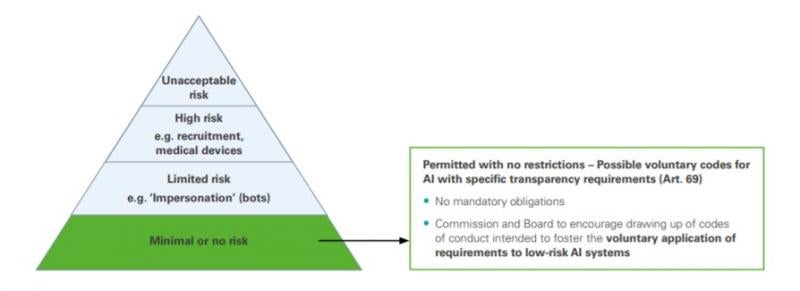Introduction
In April 2021, the EU Commission (EC) proposed a suite of new legislative and non-legislative proposals related to artificial intelligence (AI): in a proposed Regulation laying down rules on Artificial Intelligence (“Artificial Intelligence Act – AIA”), the EC attempts the first-ever comprehensive legal framework for this highly debated and fast-developing family of technologies. We set out below a high-level summary of the key policy considerations and proposed new restrictions, risk classifications and related obligations for AI providers and users stemming from this landmark proposal.
The proposed AIA is accompanied by a revised AI Coordination Plan with member states (Plan), which aims to “accelerate, act and align AI policy priorities and investments across Europe” in order to allow Europe to obtain global leadership in the development of human-centric, sustainable, secure, inclusive and trustworthy AI. The Plan also lays out the existing/planned projects related to AI at the EU level, as well as the various funding opportunities, including via the new Recovery and Resilience Facility, which foresees a 20% digital expenditure target at member state level.
The proposed AIA is accompanied by a revised AI Coordination Plan with member states (Plan), which aims to “accelerate, act and align AI policy priorities and investments across Europe” in order to allow Europe to obtain global leadership in the development of human-centric, sustainable, secure, inclusive and trustworthy AI. The Plan also lays out the existing/planned projects related to AI at the EU level, as well as the various funding opportunities, including via the new Recovery and Resilience Facility, which foresees a 20% digital expenditure target at member state level.
Furthermore, the EC has proposed a revised machinery regulatory framework in order to cater for AI technologies embedded in a broad range of consumer and professional products. The proposed new Machinery Regulation, which will replace the existing Machinery Directive (Directive 2006/42/EC), seeks to ensure safety, and established an EUwide conformity assessment when putting such AI-enhanced products on the EU market.
Status Quo of the EU Policy Debate
The AIA proposal follows the standard EU lawmaking procedure (i.e. the “ordinary legislative procedure”) and is, thus, now debated in parallel in the European Parliament (EP) and Council. The complex and far-reaching nature of the proposed AIA will undoubtedly lead to lengthy negotiations that are likely to continue well into 2022.
The EP has been particularly vocal about the need to create a regulatory framework establishing the limitations for AI technologies and robotics, especially under a well-defined civil liability regime for AI products and services. Even though the Civil Liberties, Justice and Home Affairs (LIBE) and the Legal Affairs (JURI) committees have been more involved in the early phases of the AI policy debate, the Internal Market and Consumer Protection (IMCO) Committee has been named as the leading committee for the proposed AIA. Nevertheless, the LIBE and JURI committees are keen to 1 The Slovenian Council Presidency will host a High-Level Conference on AI on 13 to 14 September 2021. 2 E.g. the High-Level Expert Group on Artificial Intelligence; the High Level Expert Group on the Impact of the Digital Transformation on EU Labor Markets; or the Expert Group on Liability and New Technologies. maintain a competence on the legislative file as Associated Committee, alongside the Industry, Research and Energy (ITRE) Committee.
The IMCO Committee Rapporteur Brando Benifei (S&D Group, Italy) hopes that the EU Parliament would be in a position to adopt its negotiating mandate by the end of 2021 – which seems very ambitious given the complexity of the AIA proposal.
The EP is expected to pursue an aggressive stance on provisions that would impact citizens’ fundamental rights, for instance in the area of remote biometric recognition. The EP is expected to suggest additional AI practices that shall be banned in the EU, and we also expect the EP to challenge the possibility to self-certify high-risk AI systems by their providers.
The Council of the EU has debated the proposed AIA at the technical level. The Council of Ministers already held a first exchange of views on the AIA proposal in June. The proposed AIA is a top priority for the Slovenian Presidency, which aims to reach a General Approach by the end of its mandate in December 2021.1 However, we expect these complex deliberations to last well into 2022, leaving it up to the French or maybe even the Czech Council Presidency to continue and possibly conclude the Council’s General Approach. While some voices among EU member states pick up on industry concerns about the potential impact of the AIA on competitiveness and innovation, a principal concern for a number of member states lies in more narrowly defined concerns about the potential for AI systems to support law enforcement, counterterrorism, etc.
The New Artificial Intelligence Act (AIA)
From a policy perspective, the EC recognises the benefits that AI can play in society, from improved medical care to better education. However, as some AI systems create risks, the EC considers that a new regulatory regime is necessary in order to protect users, including from a fundamental rights and user safety perspective without constraining the technological development. The EC also hopes to provide more clarity and legal certainty around AI in order to establish trust and excellence in AI solutions, to fuel their uptake and expansion in Europe, but also to prevent fragmentation in the European regulatory regime for AI systems.
Together with the fact that various AI-enhanced products and services are already in the EU market, the EC has proposed the first comprehensive regulatory regime for AI worldwide. The AIA proposal incorporates feedback from external stakeholders and expert groups.2
Scope
The scope of the proposed AIA3 (Title I) covers providers that place AI systems on the market, or put them into service, irrespective of whether those providers are established within or outside the EU. Users of AI systems are covered by the new rules if they are located in the EU. The AIA will even apply if the provider and user is established outside the EU, but the output produced by those systems is used in the EU. AIA will, thus, apply to providers of AI systems (e.g. a developer of a CV-screening tool), as well as users of such AI systems (e.g. a bank buying this CV-screening tool). It will not apply to private, non-professional use. In addition, AI systems exclusively developed and used for military purposes are exempt.
Risk Categorisation
The EC proposes a risk-based categorisation of AI systems with four levels of risk and related regulatory obligations and restrictions:
(i) Unacceptable Risk (Title II)
A very limited number of particularly harmful AI practices that contravene EU values are prohibited because they violate fundamental rights.4 These prohibited practices include “social scoring” by governments, the exploitation of vulnerabilities of children or otherwise disabled persons, the use of subliminal techniques that can cause physical and psychological harm and – subject to narrow exceptions – live remote biometric identification systems in publicly accessible spaces used for law enforcement purposes.

(ii) High Risk (Title III, Annex III)
Article 6 defines “high-risk” AI systems as those where the AI system is intended to be used as a safety component of a product, or is itself a product, and this product is subject to an existing third-party conformity assessment (e.g. engine-powered vehicles, trains and planes).
In addition, the EC has the power to directly designate an AI system as high risk by adding it to Annex III of the AIA, subject to certain criteria. Given the fast evolution of high-risk AI use cases, the EC proposes to review the list of covered systems on an annual basis. The EC would adopt delegated acts to change the list of high-risk AI systems in Annex III.

Annex III contains a number of AI uses cases that could (potentially) adversely affect people’s health, safety or their fundamental rights, and are, therefore, deemed “high risk”. These high-risk use cases include AI systems that, for instance, (i) use biometric identification, (ii) manage or operate critical infrastructure, (iii) are used in educational or vocational training, (iv) are used for recruiting or HR/employment-related tasks, (v) determine the access to essential private and public services, including benefits, (vi) are used in a law enforcement context, (vii) are used in a migration, asylum or border management context or (viii) are used in the administration of justice or democratic processes. 5
High-risk AI systems can only be placed on the EU market, or put into service, if they comply with certain minimum requirements. Before placing a high-risk AI system on the EU market, or otherwise putting it into service, providers must subject it to an ex-ante conformity assessment. Such a conformity assessment has to be repeated if there are substantial modifications made to the system. In certain cases, an independent notified body needs to be involved in that assessment process.
Providers of high-risk AI systems will also have to implement quality and risk management systems to ensure their compliance with the new requirements and to minimise risk for users and affected persons, even after the product has been placed on the market. Market surveillance authorities will support the post-market monitoring via audits.
For high-risk AI systems, the EC proposes a range of new mandatory requirements (Title III), including:
The establishment of a risk management system (Art. 9), which in a continuous and iterative process manages the risks associated with the AI system
-
Quality criteria regarding the training, validation and testing data sets used (Art. 10)
-
Technical documentation describing, inter alia, the compliance of the AI system with applicable rules, including for law enforcement purposes (Art. 11)
-
Record-keeping requirements to ensure an appropriate level of traceability of the AI system’s functioning (Art. 12)
-
Transparency and provision of information to enable users to interpret the system’s output and use appropriately (Art. 13)
-
Systems are effectively overseen by humans (Art. 14) • Systems need to achieve appropriate levels of accuracy, robustness and cybersecurity throughout their life cycle (Art. 15) For the providers and users of high-risk AI systems, new obligations include:
-
General obligation to observe the abovementioned list of requirements • Maintain a quality management system (Art. 17) • Ensure their systems undergo the relevant conformity assessment procedure (Art. 19)
-
Keep automatically generated logs (Art. 20)
-
Obligation to take corrective action when the AI system is not in conformity with the AIA (Art. 21), duty to notify serious incidents or any malfunctions to national competent authorities (Art. 22) and need to cooperate with these authorities (Art. 23)
-
Specific rules apply to importers of high-risk AI systems (Art. 26), as well as distributors (Art. 27) and users (Art. 29) The EC will establish a publicly accessible register of high-risk AI applications and systems (Art. 60).
(iii) Limited Risk (Title IV)
Certain AI systems will only be subject to new transparency requirements (Title IV), for instance, where there is a risk of manipulation (e.g. chatbots) or deceit (e.g. deep fakes). Natural persons should be aware that they are interacting with an AI system, unless this is obvious from the circumstances and the context of the use. Law enforcement exceptions exist.

(iv) Minimal Risk
All other AI systems can be developed and used subject to the existing legislation without any new legal obligations via the AIA. According to the EC, a large number of AI systems currently in use in the EU fall into this category. The EC is recommending voluntary codes of conduct for providers of such AI systems.

Oversight/Enforcement (Title VI)
The proposed enforcement measures foresee penalties of up to €30 million or 6% of global revenue (whichever is higher) for the most serious infringements of the new regime, making the penalty regime even more draconic than those incurred by violations of the General Data Protection Regulation (GDPR). Such is the case related to the use of prohibited AI systems and the violation of the datagovernance provisions when using high-risk AI systems.
All other cases of non-compliance with the AIA are subject to a penalty of up to €20 million or 4% of global revenue (whichever is higher). The mere supply of incorrect, incomplete or misleading information to competent authorities already carries a potential penalty payment of up to €10 million or 2% of global revenue.
Member state authorities will play a key role in the application and enforcement of the new AI regulatory regime. Newly designated national AI supervisory authorities shall supervise the AIA application, as well as carry out market surveillance activities. At the EU level, a new European Artificial Intelligence Board shall be established and will support and guide the EC and national authorities in their related activities
Although enforcement rests with member states, as is the case for GDPR, one can expect that the penalties will be phased-in, with the initial enforcement efforts concentrating on those who are not attempting to comply with the regulation. One can also expect to see ample material on how to comply with the regulation, as well as interpretive notes.
Potential Implications for Industry
Somewhat similar to the GDPR, the AIA proposal as proposed will have an extraterritorial reach and, thus, potentially affect a large number of firms with customers based in the EU. While the regime is not yet set in stone, but in the midst of the EU lawmaking process, the direction of travel suggested by the EC is clear.
Given that the proposed AI regulatory regime is the first of its kind worldwide, many experts expect it to have a major influence on other regions in the world – this is dubbed the “Brussels effect”6 – similar to what was experienced following the adoption of the GDPR. This makes it all the more important for all interested stakeholders to engage in the debate now in order to secure an adequate EU regime for AI.
While engaging in the current regulatory and policy debate is key, many organisations will also need to start preparing for the new AIA, and address the risks associated with the new AI rules more broadly.
What Is Next?
The legislative process on the AIA proposal will continue to develop in the months to come, with the debate to continue through 2022. Next to the current legislative debates, the EC will, in 2022, come forward with additional legislative measures regarding AI, focused on adapting the liability framework to be applied to emerging technologies. This will likely include a revision of the Product Liability Directive, and a legislative proposal related to the liability of AI systems. Similarly, the EC envisages proceeding with adaptations to existing sectorial safety legislation, including the General Product Safety Directive or the RadioEquipment Directive
Importantly, the EC will, in 2021, publish a Policy Program to implement Europe’s Digital Compass, which encompasses a broader range of policies relevant to align the EU’s 2030 digital ambitions. It will set out a road map on the general principles and commitments that member states will be advised to follow and concrete actions needed to address the policy objectives. Usage of AI systems is listed as one of the main areas to be developed to reach the EU’s 2030 digital ambitions, which include 75% of European enterprises having taken up cloud computing services, big data and AI solutions.
The EU envisages setting the standards that will pave the way for ethical technology worldwide while simultaneously ensuring the EU remains competitive. As evidenced by the responses to the public consultation on the proposed AIA, the industry has voiced strong concerns in relation to the far-reaching implications the future law would entail for their business. Many argue that the AIA would create unnecessary and burdensome compliance obligations, which will also be very costly for companies. On the other side of the spectrum, the civil society, trade unions and data protection authorities share the belief that the proposed law does not go far enough and should impose stronger restrictions for high-risk AI usage and compliance obligations for AI systems. Whether the proposed AIA becomes a de facto global standard setter, as for GDPR, or drives AI innovation to other jurisdictions with less intrusive legislation remains an open question
However, what seems beyond doubt is that the EU legislative process will work its way towards the first major regulation of AI systems globally, and that any company seeking to do business in or with the EU will have to comply. The legislative proposal constitutes the foundation upon which the EC will continue formulating its future policies around the various facets of AI. The ever-evolving nature of AI systems makes it difficult to ensure the legislative framework will be future-proof. However, at this stage of the legislative process, where the technical elements of the proposed law will be deliberated, this will be the ideal time to understand the direction of the negotiations. The current legislative phase provides ample opportunities to engage with policymakers in order to influence this critically important new AI regulatory regime.
What the new AI regulatory regime may mean for your organisation, and which steps can already now be taken in order to anticipate and manage the new regime. Such steps may include, inter alia, the following:
An inventory of all AI systems used by the organisation
-
A risk-classification system
-
Risk-mitigation measures
-
Independent audits
-
Data risk-management processes
-
An AI governance structure
FOOTNOTES
1 The Slovenian Council Presidency will host a High-Level Conference on AI on 13 to 14 September 2021.
2 E.g. the High-Level Expert Group on Artificial Intelligence; the High Level Expert Group on the Impact of the Digital Transformation on EU Labor Markets; or the Expert Group on Liability and New Technologies.
3 A regulation is an EU legal instrument that will directly apply in all EU member states and, thus, needs to additional step at the national level to become applicable law.
4 E.g. EU Charter of Fundamental Rights.
5 See AIA, Annex III, for details.
6 “The Brussels Effect – how the European Union rules the world”, by Anu Bradford, Oxford Press







 />i
/>i
